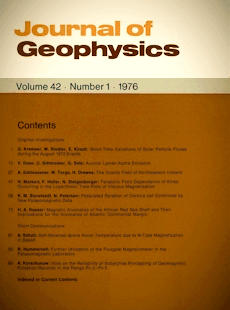Crustal structure of the Central Aegean Sea and the islands of Evia and Crete, Greece, obtained by refractional seismic experiments
Article Sidebar

Vols. 1-18 (1924-1944), ISSN 0044-2801
Main Article Content
Abstract
In 1973 and 1974 deep seismic sounding experiments were performed in the Aegean area by German and Greek geophysicists, from which two crustal sections were established. The one strikes along the islands of Amorgos-Mikonos-Andros and Evia and the other along Crete, in the E-W direction. The main results obtained are: Along the Amorgos-Mikonos-Evia section the crust is updipping from 32 km below Evia to 26 km below Amorgos in the southern Aegean Sea. The crust is of the continental type with Vpg = 6.0 km/s for the crystalline basement and 7.7 km/s for the upper mantle. The average velocity of the crust computed from Pm P-reflections has a value of 6.21 km/s. The sedimentary cover is very unevenly distributed with maximum thickness at North Evia. The crystalline basement outcrops at the southern part of the island and the Cyclades. Along Crete the crust is somewhat thicker, than that below South-Evia with 34 km at the western part and about 30 km at the eastern part of the island. At the western part of the island the nappes have their greatest thickness, the Messara Basin in the east containing the largest neogene sequences on Crete. The crustal structure of Crete is also of the average continental type.
 ARK: https://n2t.net/ark:/88439/y044462
ARK: https://n2t.net/ark:/88439/y044462
Permalink: https://geophysicsjournal.com/article/100
Article Details
References
Makris, J. (1973) Seismic refractional measurements along the line A.gina, Nafplion. Pirgos. Paper presented at the 1972 C.I.E.S.M. — Meeting in Athens
Makris, J. (1976) Geophysical investigations of the Hellenides. Hamburger Geophysikalische Einzelschriften, Heft Nr. 26, 92 pp.











